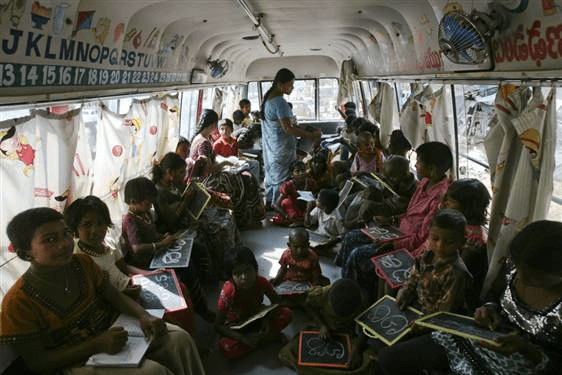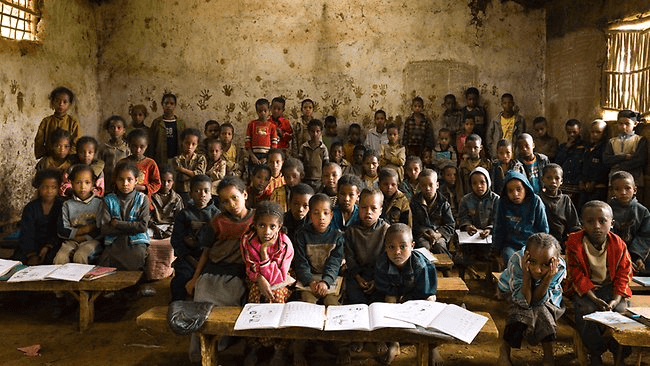Poem 2 - An Elementary School in a Slum Class 12 English Flamingo
Detailed Analysis of the Poem
Stanza – 1
The poem describes an elementary school class room in a slum. These slum children look very pathetic. Their faces are pale and reflect sadness. They are ‘like rootless weeds’ as they lack proper nutrition. Moreover, they are unwanted plants which grow on their own without being cared for, totally neglected. The tall girl has a ‘weighed – down head’ as she is burdened with the load of poverty. In fact she is so subdued and suppressed that her head had bowed down with the burden of her misfortunes. The ‘paper thin’ – extremely thin boy has ‘rat’s eyes’ because the poor undernourished boy is deprived of all the basic amenities of life. He is timid like a rat and full of anxiety, he searches for food and security. This unfortunate boy suffers from malnutrition and his growth is also ‘stunted’ – not properly developed. He has also inherited from his father ‘twisted bones’ – bent and distorted bones. He has inherited the poverty, disease and despair from his parents. His body is also deformed because of the twisted bones which he has inherited. He appears to be as sick as his parents. There is a sweet tender looking student who sits at the back of the class. This boy is different from the others as ‘his eyes live’ in a dream – he is dreaming and probably thinking about a better future. He is lost in his own world, therefore, not sad like the others. This boy thinks of the ‘squirrel’s game’ (metaphor). He wants to enjoy and play freely like the squirrel in the garden outside. The squirrel climbs trees and hides in their holes. The boy also dreams to be free but he cannot as he must sit in the dull and dreary classroom. In the boys imagination ‘tree room’ – the hollow in a tree, is full of fun, curiosity and mystery. This is in contrast to the gloomy classroom.

Stanza – 2
The classroom is not well maintained. The pale cream walls which were painted long ago with the help of donations, make the place look more miserable and sad. Probably there is a portrait of Shakespeare on the wall. This is ironical as it is put up in a place where there is no serious teaching. ‘Cloudless dawn’ and ‘civilized dome’ suggest the monotonous life in the slum. These slums are surrounded by the civilized city and the children cannot experience the beauty of the sky at dawn and are unaware of it. All around them are concrete structures of the cities. The life in the slum contrasts with the cloudless sky at dawn and concrete structures which override the cities. There is also a picture of a beautiful valley full of sweet fragrant flowers and these children of the slum will never be able to experience this beauty. They are deprived of this beauty as they are condemned to live in the slums amidst garbage. The ‘open-handed map’ in the classroom contrasts with their world. The world given to us by god is full of all the bounties whereas the world of these slum children is full of poverty and hunger. The world which they see is not the real world. Their world is confined to the narrow, dusty streets of the slum. The map in the classroom gives them hopes and aspirations and motivates them to explore the world but they will never be able to see that world. These children can get the glimpse of the outside world from the windows and it is far beyond their reach. They are far away from nature. These slum children have a bleak and foggy future in store for them. ‘Their future is painted with a fog’ – it is blurred by hopelessness. There is no hope for the slum children. Instead of the normal blue sky they live under the ‘lead sky’ – dark and dull, polluted – shows there is no hope for them. The atmosphere hints at their monotonous life and the slum children remain confined throughout their lives confined to the filth and dirt of the narrow slum streets. They are away from the glory of natural beauty of the rivers, mountains, stars etc
 Fig: An elementary classroom in slum.
Fig: An elementary classroom in slum.
Stanza 3
The children of the slum are fighting the battle of life unarmed. They are troubled by disease and despair. For them Shakespeare is ‘wicked’ and ‘map’ a bad example’. The literary excellence of Shakespeare and the scenic beauty portrayed in the map cannot relieve them from their despair. For these slum children, literary excellence is a far-fetched thing and hence seems wicked. The map on the wall gives them false aspirations as it makes them aware of the beautiful world given by god. The world of these children is confined to the narrow streets of the slums. Therefore, map is ‘a bad example’. They feel cheated in being deprived of the thrilling sensations of the sun, the ships, and the emotions of love. The ‘ship’, ‘sun’ and ‘love’ symbolize joy and happiness which these children are deprived of. Their only experience is that of hunger and poverty. To reach out to the world beyond, these children are sometimes tempted to adopt wrong means even stealing to fulfill their dreams.
These slum children live in cramped holes, striving and struggling for survival in the small, dirty rooms from ‘fog to endless night’ – from foggy mornings till long endless nights, trying to meet both ends. The slum children live on ‘slag heaps’ – piles of waste material. Their world is full of dirt and garbage. These children are very weak and undernourished. They look like skeletons as their bones peep through their thin skin.
They wear ‘spectacles of steel with mended glass’ – discarded spectacles by the rich, mended (repaired) and worn.
Their life is like ‘bottle bits on stones – shattered and broken like bits of bottle on a stone. They are deprived of even the basic amenities of life. Their world is comprised of the foggy slums where they live nightmares. Slums are the reality for these children, their home, where they spend their life. The maps displayed in their classroom are no reality for them. They cannot locate their slum in that map. It is urgently required to give these slum inhabitants means and opportunities to lead a dignified and civilized life.
Stanza – 4
The elementary school in the slum exists for name sake. The infrastructure is poor with hardly any serious teaching. The school springs in activity only when a governor, a school inspector or a visitor comes on a round of the school. The administrative machinery of the school also gears up at that time. Then the map becomes their window from where they can see the world beyond their slums. Since they are confined to the slums, these sights and glimpses are shut upon them as they are deprived of all opportunities and means. Their lives are shut up in the cemeteries of these slums where they slither and slog to make both ends meet. The poet hopes that these children will break free from their morbid life, from the chains of the slums. He appeals to those in power to liberate these children from the miserable slums and enable them to breathe in the fresh, beautiful and healthy environment away from the foggy slums. They should be able to bask in the open green fields and let them run free on the golden sands. Their world should not be confined to the horrendous and gory slums. The poet visualizes freedom for these children. He wants a carefree life where they get economic and social justice, where they have the right to be happy. These slum children should be able to enjoy the fundamental right of education otherwise their lives will be miserable. They should be able to learn not from the books alone but also from the world, the nature around them.
The poet ends on a note of positivity and wants opportunities to be available to these children. The people who strive for knowledge are the ones who create history. The ones who are let free are the ones who will create history. People who outshine others, who glow like the sun, who break free from the constraints of their restricted life are the ones who create history.
|
10 videos|43 docs|58 tests
|
FAQs on Poem 2 - An Elementary School in a Slum Class 12 English Flamingo
| 1. What is the poem "An Elementary School in a Slum" about? |  |
| 2. What is the tone of the poem "An Elementary School in a Slum"? |  |
| 3. What literary devices are used in the poem "An Elementary School in a Slum"? |  |
| 4. What is the message conveyed by the poem "An Elementary School in a Slum"? |  |
| 5. Who is the speaker in the poem "An Elementary School in a Slum"? |  |






















